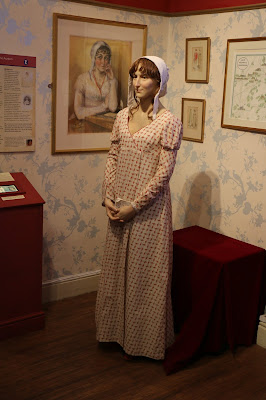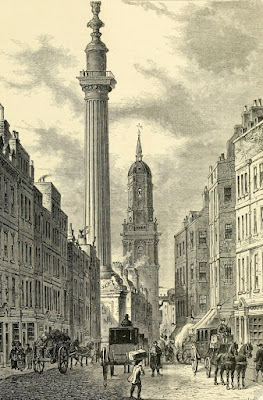 |
| Portrait and waxwork of Jane Austen on display at the Jane Austen Centre in Bath |
If you want to learn about Jane Austen, my favourite author and one of Bath’s most famous residents, the Jane Austen Centre is an excellent place to start.
I recently visited the centre to talk to their social media manager, Jenni Waugh, about my book, What Regency Women Did For Us, which features Jane Austen. You can find my interview on the Jane Austen website here: An interview with author Rachel Knowles.
For those of you who have never visited the Jane Austen Centre, here is my guide to what you might discover there.
Where is the Jane Austen Centre?
The Jane Austen Centre is at 40 Gay Street in Bath. It is situated in a Georgian townhouse much like the one Jane once lived in, just up the road at number 25.
 |
| The Jane Austen Centre, 40 Gay Street, Bath |
Visitors to the Jane Austen Centre are transported back 200 years as they are welcomed at the door by the much-photographed figure of Martin Salter, dressed in Regency costume. Within the centre, all the staff are in Regency costume – even the man operating the till.
 |
| Martin Salter ready to welcome visitors to the Jane Austen Centre in Bath |
The tour starts upstairs with an introductory talk about Jane Austen by one of the centre’s costumed guides, who each take on the persona of one of Jane Austen’s characters. Our talk was given most proficiently by ‘Georgiana Darcy’, who introduced her audience to Jane and the Austen family, and told the story of Jane’s life.
The exhibition
The main exhibition is on the ground floor, starting with a corridor of Jane Austen pictures which our guide talked about. Sadly, none were original, but the reproduction of Cassandra’s famous sketch of Jane Austen did have the advantage of being somewhat larger than the original, which is in the National Portrait Gallery in London.
Throughout the exhibition, there were display boards giving information about the houses in which Jane lived in Bath and other facts about her family, her loves, and the life she led.
 |
| Rachel at the exhibition at the Jane Austen Centre in Bath |
If you are a fan of the 1995 BBC adaptation of Pride and Prejudice, then you will recognise Adrian Lukis, the presenter of a short video detailing the places in Bath that Jane was associated with. Adrian played the charming but villainous George Wickham.
 |
| View through the window of the milliner's shop at the Jane Austen Centre in Bath |
One of the most fascinating exhibits was a little shop, filled with items you might have found in a milliner’s shop in Georgian England, including glove stretchers and feathers.
 |
| Regency costumes on display at the Jane Austen Centre in Bath |
As well as displaying various Regency costumes, there was the chance to dress up. Visitors can choose from an array of Regency gowns, gloves, shawls and hats, and pose with the model of Mr Darcy.
Moving on, there was a chance to practise writing with pen and ink, and discover how hard it is to write without blotting ink all over your paper.
 |
| Rachel in Regency costume posing with Mr Darcy at the Jane Austen Centre in Bath |
 |
| Rachel trying to write with a pen and ink at the Jane Austen Centre in Bath |
Finally, the pinnacle of the exhibition – the life-size, waxwork figure of Jane Austen based on forensic artist Melissa Dring’s speculative portrait. I have wanted to see this waxwork, created by sculptor Mark Richards, whose clients include Madame Tussaud’s, ever since I first read about it.
 |
| Portrait and waxwork of Jane Austen on display at the Jane Austen Centre in Bath |
The most surprising thing for many people is the revelation that Jane was quite tall. As you will see from the photo of Jane and myself, she is by far the taller of the two. I believe Jane’s height was worked out from a pelisse she once owned, showing her to be around 5 feet 6 inches tall.
 |
| Rachel with the waxwork of Jane Austen on display at the Jane Austen Centre in Bath |
Alongside the statue is another piece of Jane Austen memorabilia: one of the five new polymer £5 notes depicting a miniature engraving of Jane’s face on it, together with a quote from one of her books. Artist Graham Short made the engravings, and he donated this £5 note to the Jane Austen Centre in Bath to go on display.
Souvenir shopping
After visiting the exhibition, you can browse the gift shop, where you can purchase all manner of items related to Jane Austen, many of which have Mr Darcy’s name or face on them.
If you want a reminder of what you’ve learned at the centre, the souvenir guide is full of facts about Jane Austen’s residence in Bath, and includes a family tree and timeline, as well as a Regency tour of Bath.
 |
| Regency tearooms at the Jane Austen Centre in Bath |
You can finish your tour where I started mine, right at the top of the house in the Regency tearooms, where Jenni Waugh interviewed me. Here you can sip tea, served by staff in Regency costume, while admiring the portrait of Mr Darcy, as depicted by Colin Firth in the BBC’s classic 1995 dramatization of Pride and Prejudice.
 |
| Rachel with Jenni Waugh and Mr Darcy in the Regency tearooms at the Jane Austen Centre in Bath |
Probably not, but don’t let that put you off. I knew a lot about Jane Austen before my visit as I wrote about her in What Regency Women Did For Us, and I would have found it quite disturbing if I had discovered a lot of new facts that I wish I had included!
Did I enjoy my visit?
What was the best part?
The highlight of my visit was undoubtedly seeing the Jane Austen waxwork.
 |
| Waxwork of Jane Austen on display at the Jane Austen Centre in Bath |
You can find out more about visiting the centre here: Visiting the Jane Austen Centre in Bath
Last visited October 2017.
All photos © Regencyhistory.net
Rachel Knowles writes clean/Christian Regency era romance and historical non-fiction. She has been sharing her research on this blog since 2011. Rachel lives in the beautiful Georgian seaside town of Weymouth, Dorset, on the south coast of England, with her husband, Andrew.
Find out more about Rachel's books and sign up for her newsletter here.If you have enjoyed this blog and want to encourage me and help me to keep making my research freely available, please buy me a virtual cup of coffee by clicking the button below.





















